Early years
On Sunday 31 October 1811, after the morning service had finished, Charles and Mary
Steward baptised their daughter, Sarah Ann at Christ Church in Spitalfields. It was
an event that would occur about every two years, and on Sunday, 25 July 1813, they
baptised another daughter,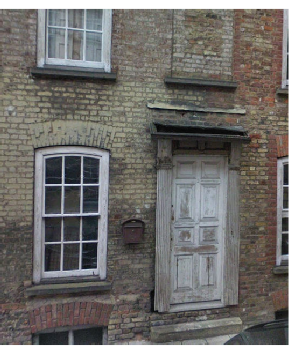 Mary Ann. Charles followed in 1815, Ann Martha in January
1817, Eliza in May 1819 and Esther in April 1821. In all, five daughters and a son.
As they grew up, the girls’ days were filled with learning those skills that they
would need, hopefully, as wives and mothers: running the house, cooking, washing
and needlework, as well as learning to read and write, no doubt a legancy of their
maternal Huguenot heritage.
Mary Ann. Charles followed in 1815, Ann Martha in January
1817, Eliza in May 1819 and Esther in April 1821. In all, five daughters and a son.
As they grew up, the girls’ days were filled with learning those skills that they
would need, hopefully, as wives and mothers: running the house, cooking, washing
and needlework, as well as learning to read and write, no doubt a legancy of their
maternal Huguenot heritage.
When their father died in 1824 at the age of about forty, the girls were equipped
with valuable skills. Eliza and Esther both found husbands. Sarah Ann gained employment
as a cook, a position which was a step up from the ordinary domestic servant and
which paid twice the wages of a house maid. Mary Ann and Ann Martha also put their
skills to use. In 1841, Mary was working as a dress maker and Ann Martha as a straw
bonnet maker. T he ladies collected the materials and orders from their employer and
carried out the work at home, returning the finished garments and bonnets to their
employer at the appointed time. During this time, Mary Ann and Ann Martha were living
at 2 Wilkes Street in Spitalfields with their mother, Mary, and grandmother, Ann
Ducrow. It was a respectable address and made possible because of Ann Ducrow’s independent
income. Perhaps they worked in the garret room where the elongated windows allowed
the light to flood in. If so, and if they had glanced up, they would have seen the
familiar spire of Christ Church towering over them, the chimes of its bells regulating
their waking hours. The photographs show (above) the front door of 2 Wilkes Street
and (right) a view of Christ Church from the garret room. The map below shows Wilkes
Street (Wood Street) in about 1800.
he ladies collected the materials and orders from their employer and
carried out the work at home, returning the finished garments and bonnets to their
employer at the appointed time. During this time, Mary Ann and Ann Martha were living
at 2 Wilkes Street in Spitalfields with their mother, Mary, and grandmother, Ann
Ducrow. It was a respectable address and made possible because of Ann Ducrow’s independent
income. Perhaps they worked in the garret room where the elongated windows allowed
the light to flood in. If so, and if they had glanced up, they would have seen the
familiar spire of Christ Church towering over them, the chimes of its bells regulating
their waking hours. The photographs show (above) the front door of 2 Wilkes Street
and (right) a view of Christ Church from the garret room. The map below shows Wilkes
Street (Wood Street) in about 1800.
A change in circumstance
I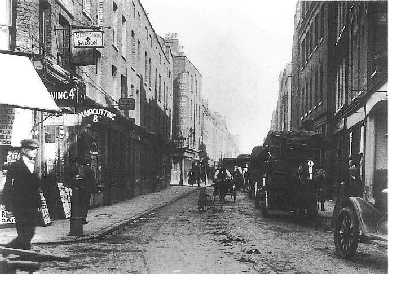 n March 1845, Ann Ducro, then in her eighties, died. Presumably their grandmother’s
income ceased (although see below), and Mary Ann and Ann Martha left the faded gentility
of Wilkes Street and moved to a crowded house in Browns Lane (now Hanbury Street)
with their mother. Although it was only two streets away, it was a step down in the
world. The photograph on the left shows Hanbury Street in 1918, and the map below
shows its location.
n March 1845, Ann Ducro, then in her eighties, died. Presumably their grandmother’s
income ceased (although see below), and Mary Ann and Ann Martha left the faded gentility
of Wilkes Street and moved to a crowded house in Browns Lane (now Hanbury Street)
with their mother. Although it was only two streets away, it was a step down in the
world. The photograph on the left shows Hanbury Street in 1918, and the map below
shows its location.
By the time of the next census in 1851, Mary had ceased dressmaking and was working
as a milliner. With the advent of mechanised sewing machines, perhaps she was able
to put her skills to better use by making hats, although the occupation was generally
poorly paid, and dictated by the London season. The illustration below shows a French
millinery shop in London; the gentleman appears more interested in examining the
pretty, rather brazen, milliner than the bonnet she is holding, much to the blushes
of his plain wife. Women in the millinery trade, whose whose skills were most in
d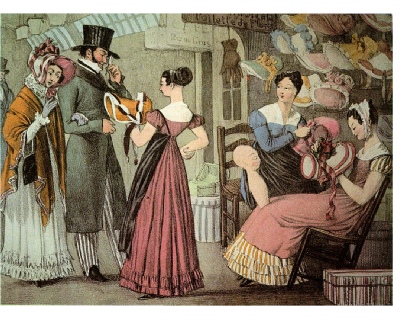 emand during the London society 'season', were often forced to supplement their
income in quieter months through prostitution, and London's fashionable Burlington
Arcade doubled as an upmarket red-light district in the late afternoons, although
there is nothing to suggest that the Ducro ladies had to resort to such measures.
emand during the London society 'season', were often forced to supplement their
income in quieter months through prostitution, and London's fashionable Burlington
Arcade doubled as an upmarket red-light district in the late afternoons, although
there is nothing to suggest that the Ducro ladies had to resort to such measures.
The decline of Spitalfields
By 1871, Mary Ann and Ann Martha were unable to take care of their infirm mother
and had little choice but to resign her to the workhouse. Mary Ann and Ann Martha
continued to living at 25 Browns Lane for another decade. But between 1871 and 1881,
after more than twenty years, they moved to 35 Booth Street (now Princelet Street
which lies to the east side of Brick Lane). It was a three-storey house with two
rooms front to back on each floor, and living in the house in 1881 were nine adults
and one child: the owner and his wife and son, a tailor and his wife, and three sisters
of French descent,  two of whom were fur sewers and the other a bonnet shape maker
(the photograph on the right shows Princelet Street today).
two of whom were fur sewers and the other a bonnet shape maker
(the photograph on the right shows Princelet Street today).
Since the 1680s, the character of Spitalfields has transformed constantly, its changes
mirroring the rise and fall of its economic fortunes. By the 1850s, although the
mass immigration of Jewish refugees from eastern Europe had not yet begun, there
was a small enclave of Dutch Jews in the area known as ‘Tenter ground’ and a synagogue
opened in 1869 at 19 Princelet Street (now Princes Street). Twenty years later, Spitalfields
and neighbouring Whitechapel had sunk to their lowest point. Desperately overcrowded,
they contained some of the most notorious slums in London: Flower and Dean Street
(one streets south of Fashion Street) was described as "perhaps the foulest and most
dangerous street in the whole metropolis" and Dorset Street (which ran west from
Red Lion Street) was called "the worst street in London", notorious for its doss
houses, each one of which might sleep up to 400 people a night for 4d or 6d. Robbery,
violence, homelessness, drunkenness and prostitution were endemic;  the Police Commission
estimated that there were 62 brothels in Whitechapel and 1,200 prostitutes (the estimated
number of prostitutes in London varies from a modest 7,000 to a staggering 80,000
depending on whether it was the Police Department or the Society for the Suppression
of Vice who was doing the estimating; scholars believe the Society's guess may be
closer to the truth, which would equate to more than one prostitute for every twelve
adult males in Greater London in the mid-nineteenth century).
the Police Commission
estimated that there were 62 brothels in Whitechapel and 1,200 prostitutes (the estimated
number of prostitutes in London varies from a modest 7,000 to a staggering 80,000
depending on whether it was the Police Department or the Society for the Suppression
of Vice who was doing the estimating; scholars believe the Society's guess may be
closer to the truth, which would equate to more than one prostitute for every twelve
adult males in Greater London in the mid-nineteenth century).
Hard times
One wonders how the two sisters reacted to their changing environment. On the face
of it, they were two aged spinsters sewing bonnets in a rented room. Did they fear
the outside world or had they adapted to it? Did they maintain their respectability
in the sea of vice that surrounded them, reflected in the grim faces that stare out
from the photograph of Dorset Street below? Given that they appear to have lived
in respectable households, supplementing their small income with their needle, without
the support of father, husband or brother, it would appear they managed. That they
remained in Spitalfields, despite its declining fortunes, was due to its familiarity
and the fact that their family had called it home for over 100 years. 
Mary Ann and Ann Martha continued to work as milliners and by 1888 had moved to 34
Elder Street, a respectable street of Georgian houses that had once been rather grand.
It was where Ann Martha died on 18 February 1888 of bronchitis, her sisters Mary
Ann and Eliza (Fisher) by her side.
Ann Martha’s was most likely an unremarkable life and her passing went unnoticed
by all but a few. However, later that year, Spitalfields and Whitechapel were gripped
by a series of murders which drew the attention of the world on the streets that
had been familiar to Ann Martha during her life, and where Mary still lived.
In the grip of fear
On the morning of 8 August 1888 the body of a woman, later identified as Martha Tabram,
was discovered at George Yard Buildings in Whitechapel. Three weeks later, in the
early hours of the morning of 31 August, the mutilated body of Mary Ann ‘Polly’ Nichols
was found at Buck’s Row (Durward Street). Although drunken brawls and domestic violence
were a commonplace in Whitechapel, murder was a rare occurrence and it aroused a
certain amount of public interest, with people stopping in the street to discuss
the case. But it was the discovery of Annie Chapman’s mutilated body on the morning
of 9 September at 29 Hanbury Street that captured public attention. As news of the
murder spread, public anxiety turned into panic and a large crowd congregated in
front of the house in Hanbury Street. Curious onlookers arrived and householders
rented seats by windows overlooking the fatal spot. Costermongers did a brisk trade
selling provisions to the crowd, newspapers enjoyed massive sales and broadsheets,
some in verse and sung by hawkers to popular tunes, appeared in almost every street.
Living only 300 meters from the crime scene, Mary heard the news quickly as word
spread; it must have been a shock to her to learn that Mary Chapman’s body had been
discovered only two doors from where she had lived only ten years earlier, particularly
now she was living alone. The double murders of Elizabeth Stride and Catherine Eddowes
on the night of Sunday 30 September only fuelled rising fears stoked by press speculation
and sensationalism.
Five weeks later on 9 November, the world awoke to the news that another victim had
been found in nearby Dorset Street. Mary knew the street well and had walked down
it countless times in her youth, even if, in recent years, she avoided it due to
its very low character — it ran opposite Christ Church where Mary and her family
had been baptised, married and buried over the centuries. If Mary had not heard about
the murder soon after she had woken, it would have soon be brought to her attention.
It was the day of the Lord Mayor’s parade, but as news burst upon the crowd, thousands
deserted the parade route and converged on Dorset Street, and no doubt Elder Street
reverberated with the sound of footsteps and animated voices. With police cordoning
off the street, Bell Street and Commercial Street at either end became choked with
frightened but excited people.
After at least five brutal murders, the east end waited with baited breath. However,
whilst there were attempts to link other murders to the ‘Ripper’, Mary Kelly is generally
considered to be the last of his victims, and eventually Whitechapel breathed a sigh
of relief, although it is doubtful that any woman who lived through that Summer of
fear felt truly safe walking the streets after dark — not that any respectable woman
would be seen on the streets alone after dark, certainly not Mary who was by now
75 years old. The map below shows in blue the locations where the Ripper’s victims
were found; the places where Mary Ann and Ann Martha lived are show in orange.
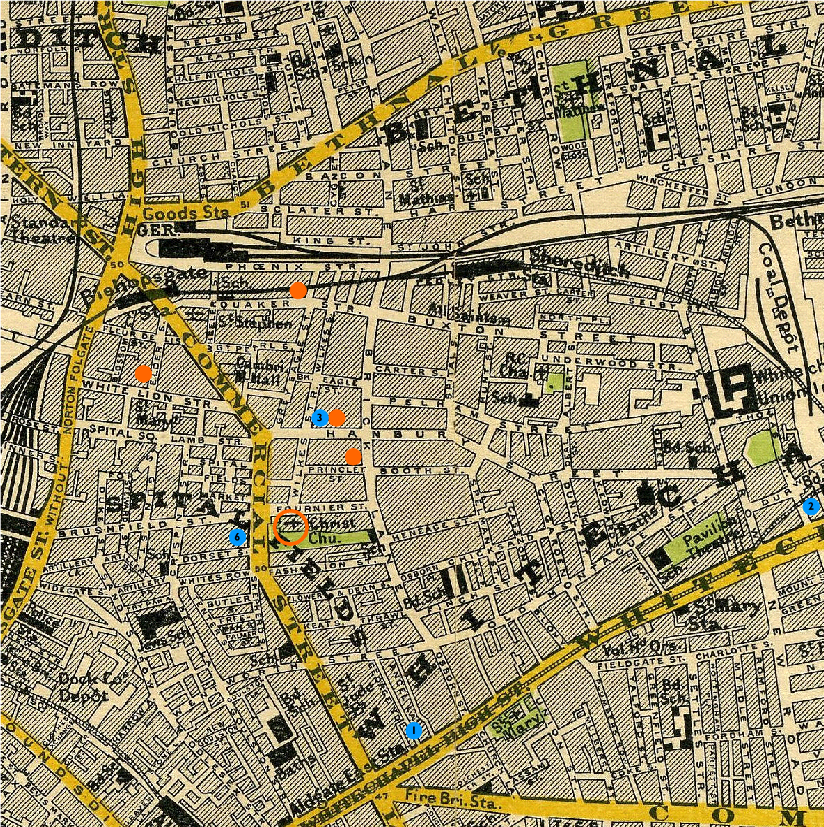
The final years
Mary continued to live at 34 Elder Street (pictured below) for another five years,
and in the 1891 census was shown as occupying two rooms and living on private means.
The most likely explanation is that she had an annuity which produced a small income.
As Mary Ann’s grandmother, Ann Ducro, had independent means, perhaps this income
passed had to her daughter, Mary, and on her to death, to her daughters. It would
explain how three generations of Steward ladies were able to live in relative comfort
pursuing occupations that were known for paying relatively poor wages. Certainly,
there do not appear to have been any relatives who were capable of supporting Mary
financially. 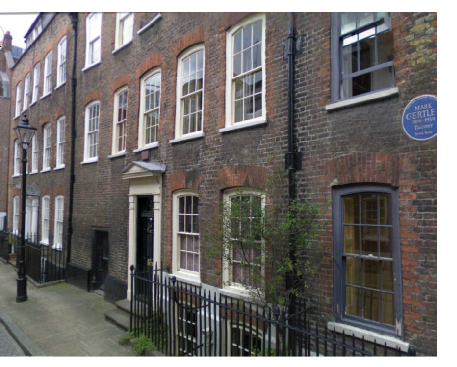 Although Mary’s sister and brother-in-law, Eliza and Jesse Fisher, had
enjoyed a relatively good standard of living, they had fallen on hard times and were
living in an Almshouse in Wood Green. Mary’s other sister, Esther, would also be
in a workhouse ten years later. Whatever the case, Mary Ann remained fit and healthy
enough to live at Elder Street until her death on 20 September 1893 of natural causes.
Present at the death was her niece, Emily Fowle (née Hockerday). Emily was the daughter
of Esther Steward, Mary’s sister, by Thomas Hockerday. At the time of Mary’s death,
Esther was living with Emily and her family in Hackney, so it was clear that the
family kept in touch.
Although Mary’s sister and brother-in-law, Eliza and Jesse Fisher, had
enjoyed a relatively good standard of living, they had fallen on hard times and were
living in an Almshouse in Wood Green. Mary’s other sister, Esther, would also be
in a workhouse ten years later. Whatever the case, Mary Ann remained fit and healthy
enough to live at Elder Street until her death on 20 September 1893 of natural causes.
Present at the death was her niece, Emily Fowle (née Hockerday). Emily was the daughter
of Esther Steward, Mary’s sister, by Thomas Hockerday. At the time of Mary’s death,
Esther was living with Emily and her family in Hackney, so it was clear that the
family kept in touch.
Two weeks after her death, probate was granted. It shows that her estate was valued
at £132 11s 8d — t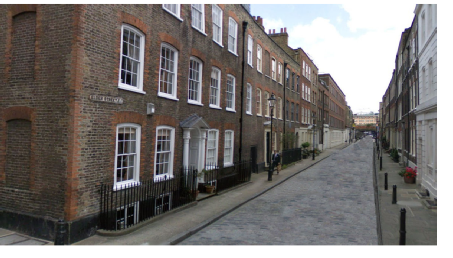 he equivalent of almost two years’ wages for a craftsman at that
time. Although not a fortune, it shows a capable and sensible woman who had been
able to live in modest comfort without a husband. She was certainly better off than
her married sisters.
he equivalent of almost two years’ wages for a craftsman at that
time. Although not a fortune, it shows a capable and sensible woman who had been
able to live in modest comfort without a husband. She was certainly better off than
her married sisters.
By the time of Mary’s death, the burial grounds of London’s churches were full and
no burials had taken place at Christ Church for over thirty years. As a result, Mary
could not be buried in the same turf as her ancestors and her actual place of burial
is unknown.
Eliza Steward was baptised on 2 May 1819 at Christ Church. She married Jess James
Fisher on 9 June 1839 at the Church of St John the Baptist, Hoxton. Jesse had been
born in 1816 in Clerkenwell to Jesse and Maria Ann (née Vanhagen) Fisher whilst his
parents were living at Baltic Street (situated between the Barbican and Old Street).
Like his father, Jesse was a poulterer. After their marriage, Jesse and Eliza lived
in Quaker Street in Spitalfields near to where Eliza had grown up. By the 1850s,
their business was thriving and the family moved to Brown Street near St George Hanover
Square. They continued to live there until at least 1871 with their seven children.
By about 1879, Eliza and Jesse had fallen on hard times. Fortunately, the Institution
of the Fishmongers and Poulterers’ Company provided assistance. 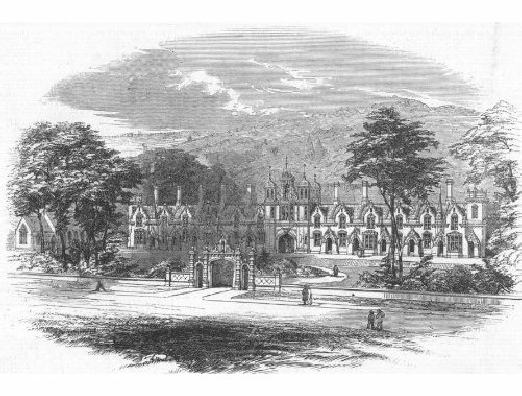 The Institution had
been established in 1835 and provided pensions and assistance to people in the trade
who were in reduced circumstances. In June 1847, work also began on the building
of a two-storey Tudor style almshouse in Wood Green (pictured on the right), one
of a number of institutes to choose Wood Green, which was favoured for its quiet,
rural surroundings. The almshouses were completed in 1850 and continued until the
early 1950s. Jesse and Eliza were given a house at the almshouse; one of only 12
houses available. They moved in shortly after the widow of the previous recipient
(John Marsh) died on 23 March 1879. Jesse and Eliza remained at number 11 until their
deaths: Eliza in 1893 and Jesse in 1897. Despite his reduced circumstances, Jesse
left £32 to his son, Thomas.
The Institution had
been established in 1835 and provided pensions and assistance to people in the trade
who were in reduced circumstances. In June 1847, work also began on the building
of a two-storey Tudor style almshouse in Wood Green (pictured on the right), one
of a number of institutes to choose Wood Green, which was favoured for its quiet,
rural surroundings. The almshouses were completed in 1850 and continued until the
early 1950s. Jesse and Eliza were given a house at the almshouse; one of only 12
houses available. They moved in shortly after the widow of the previous recipient
(John Marsh) died on 23 March 1879. Jesse and Eliza remained at number 11 until their
deaths: Eliza in 1893 and Jesse in 1897. Despite his reduced circumstances, Jesse
left £32 to his son, Thomas.


 Mary Ann. Charles followed in 1815, Ann Martha in January
1817, Eliza in May 1819 and Esther in April 1821. In all, five daughters and a son.
As they grew up, the girls’ days were filled with learning those skills that they
would need, hopefully, as wives and mothers: running the house, cooking, washing
and needlework, as well as learning to read and write, no doubt a legancy of their
maternal Huguenot heritage.
Mary Ann. Charles followed in 1815, Ann Martha in January
1817, Eliza in May 1819 and Esther in April 1821. In all, five daughters and a son.
As they grew up, the girls’ days were filled with learning those skills that they
would need, hopefully, as wives and mothers: running the house, cooking, washing
and needlework, as well as learning to read and write, no doubt a legancy of their
maternal Huguenot heritage.  he ladies collected the materials and orders from their employer and
carried out the work at home, returning the finished garments and bonnets to their
employer at the appointed time. During this time, Mary Ann and Ann Martha were living
at 2 Wilkes Street in Spitalfields with their mother, Mary, and grandmother, Ann
Ducrow. It was a respectable address and made possible because of Ann Ducrow’s independent
income. Perhaps they worked in the garret room where the elongated windows allowed
the light to flood in. If so, and if they had glanced up, they would have seen the
familiar spire of Christ Church towering over them, the chimes of its bells regulating
their waking hours. The photographs show (above) the front door of 2 Wilkes Street
and (right) a view of Christ Church from the garret room. The map below shows Wilkes
Street (Wood Street) in about 1800.
he ladies collected the materials and orders from their employer and
carried out the work at home, returning the finished garments and bonnets to their
employer at the appointed time. During this time, Mary Ann and Ann Martha were living
at 2 Wilkes Street in Spitalfields with their mother, Mary, and grandmother, Ann
Ducrow. It was a respectable address and made possible because of Ann Ducrow’s independent
income. Perhaps they worked in the garret room where the elongated windows allowed
the light to flood in. If so, and if they had glanced up, they would have seen the
familiar spire of Christ Church towering over them, the chimes of its bells regulating
their waking hours. The photographs show (above) the front door of 2 Wilkes Street
and (right) a view of Christ Church from the garret room. The map below shows Wilkes
Street (Wood Street) in about 1800. n March 1845, Ann Ducro, then in her eighties, died. Presumably their grandmother’s
income ceased (although see below), and Mary Ann and Ann Martha left the faded gentility
of Wilkes Street and moved to a crowded house in Browns Lane (now Hanbury Street)
with their mother. Although it was only two streets away, it was a step down in the
world. The photograph on the left shows Hanbury Street in 1918, and the map below
shows its location.
n March 1845, Ann Ducro, then in her eighties, died. Presumably their grandmother’s
income ceased (although see below), and Mary Ann and Ann Martha left the faded gentility
of Wilkes Street and moved to a crowded house in Browns Lane (now Hanbury Street)
with their mother. Although it was only two streets away, it was a step down in the
world. The photograph on the left shows Hanbury Street in 1918, and the map below
shows its location. emand during the London society 'season', were often forced to supplement their
income in quieter months through prostitution, and London's fashionable Burlington
Arcade doubled as an upmarket red-
emand during the London society 'season', were often forced to supplement their
income in quieter months through prostitution, and London's fashionable Burlington
Arcade doubled as an upmarket red- two of whom were fur sewers and the other a bonnet shape maker
(the photograph on the right shows Princelet Street today).
two of whom were fur sewers and the other a bonnet shape maker
(the photograph on the right shows Princelet Street today).  the Police Commission
estimated that there were 62 brothels in Whitechapel and 1,200 prostitutes (the estimated
number of prostitutes in London varies from a modest 7,000 to a staggering 80,000
depending on whether it was the Police Department or the Society for the Suppression
of Vice who was doing the estimating; scholars believe the Society's guess may be
closer to the truth, which would equate to more than one prostitute for every twelve
adult males in Greater London in the mid-
the Police Commission
estimated that there were 62 brothels in Whitechapel and 1,200 prostitutes (the estimated
number of prostitutes in London varies from a modest 7,000 to a staggering 80,000
depending on whether it was the Police Department or the Society for the Suppression
of Vice who was doing the estimating; scholars believe the Society's guess may be
closer to the truth, which would equate to more than one prostitute for every twelve
adult males in Greater London in the mid-

 Although Mary’s sister and brother-
Although Mary’s sister and brother- he equivalent of almost two years’ wages for a craftsman at that
time. Although not a fortune, it shows a capable and sensible woman who had been
able to live in modest comfort without a husband. She was certainly better off than
her married sisters.
he equivalent of almost two years’ wages for a craftsman at that
time. Although not a fortune, it shows a capable and sensible woman who had been
able to live in modest comfort without a husband. She was certainly better off than
her married sisters.  The Institution had
been established in 1835 and provided pensions and assistance to people in the trade
who were in reduced circumstances. In June 1847, work also began on the building
of a two-
The Institution had
been established in 1835 and provided pensions and assistance to people in the trade
who were in reduced circumstances. In June 1847, work also began on the building
of a two-